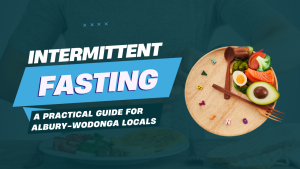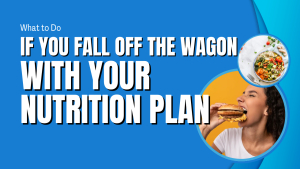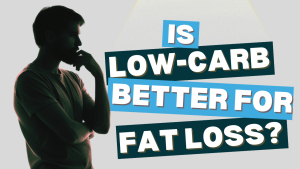Items filtered by date: April 2025
How to Stay on Track with Your Diet at Social Events
Sticking to your nutrition plan is easy when you're at home, meal prepped, and in control. But what about when you're at a BBQ, birthday dinner, or social event?
If you’re working with a personal trainer in Albury Wodonga or trying to improve your health, you don’t have to choose between social life and your goals. With a little planning, you can enjoy your time out and stay on track.
Here’s your local guide to navigating social events while dieting in Albury Wodonga.
1. Plan Ahead
If you’re heading to a local pub, restaurant, or family event, check out the menu ahead of time. Knowing what you’ll eat before you get there helps avoid impulsive decisions that don’t align with your goals.
Pro tip: Many venues in Albury Wodonga offer grilled proteins, salads, and healthier sides—just ask!
2. Stay Hydrated
Drink water before, during, and after the event. Hydration helps control appetite and stops you from mistaking thirst for hunger.
Bringing a water bottle to events or ordering a sparkling water with lemon can be a game-changer—especially when alcohol is flowing.
3. Moderation, Not Deprivation
Treats are fine in moderation. You don’t have to be perfect to make progress. Enjoy small portions of your favourite foods without guilt and avoid going back for seconds “just because it’s there.”
4. Choose Smart Options
Look for grilled, baked, or roasted meals instead of fried. Opt for lean protein and veggies as your base, and build from there.
Albury Wodonga has plenty of health-conscious cafés and restaurants. Ask for modifications—you’ll be surprised how accommodating local spots can be.
5. Don’t Skip Meals
Skipping meals to “save calories” often leads to binge eating later on. Instead, stick to your regular eating pattern so you arrive at the event with balanced blood sugar and a level head.
6. Bring Something Healthy
If you're headed to a potluck, family gathering, or barbecue in the Wodonga or Albury area, bring a healthy dish you enjoy. That way, you’ve guaranteed at least one meal option that fits your plan.
7. Focus on the Fun, Not Just the Food
Social events are about people, not just plates. Shift your focus to conversations, games, or catching up—rather than constantly scanning the food table.
Whether you're at Noreuil Park for a picnic or hosting at home, create connection, not just consumption.
8. Get Moving
Take part in physical activities during events—walks by the Murray River, backyard cricket, a dance floor session. These small bursts of activity add up and help regulate appetite and mood.
9. Manage Alcohol
Alcohol is high in empty calories and lowers your decision-making power. If you’re drinking, alternate with water, opt for lower-calorie options, and keep it moderate.
Final Thought
At PT Fitness Albury Wodonga, we believe in real-life nutrition coaching that works beyond the gym. You don’t need to miss out on fun to hit your goals. With some strategy and support, you can enjoy every part of your lifestyle while still seeing progress.
Need Help With Your Nutrition Plan?
If you're looking for nutrition coaching in Albury Wodonga, or want a flexible, results-driven program tailored to you, our personal trainers are here to help. Book a free consultation today and take the guesswork out of your health journey.
Core Bracing for Strength & Injury Prevention: A Must-Know for Albury Wodonga Lifters
If you're training in a gym around Albury or Wodonga and want to build serious strength, reduce injury risk, and improve your performance, there's one technique you need to master first—core bracing.
At PT Fitness Albury Wodonga, we coach our clients on the fundamentals of movement, and core bracing is at the top of the list. Whether you're lifting weights, training for sport, or just looking to feel more stable and strong, this simple concept makes a huge difference.
What is Core Bracing?
Core bracing refers to the intentional engagement of your midsection muscles—your abs, obliques, deep core, and lower back—to create pressure and protect your spine during movement. It’s the foundation of safe and effective strength training.
Think of your core like a natural weightlifting belt. When you brace properly, your trunk becomes a stable pillar, allowing you to lift heavier and move more efficiently with less risk of injury.
Why is Core Bracing So Important?
1. Injury Prevention
Improper lifting technique is one of the most common reasons people injure themselves in the gym. Bracing stabilises your spine and protects your lower back, hips, and shoulders during loaded movements like squats and deadlifts.
2. Better Strength and Power
A strong brace improves force transfer through the body. This means you can generate more power in lifts, jumps, and sprints—essential for athletes and everyday gym-goers alike.
3. Improved Movement Efficiency
When your core is stable, your limbs can move more freely. This leads to better balance, control, and overall coordination.
How to Brace Your Core Correctly
Here’s a step-by-step guide we use at PT Fitness Albury Wodonga:
✅ Inhale Deeply Into Your Belly
Take a big breath in—not into your chest, but into your lower torso. You should feel your belly and sides expand.
✅ Create Outward Pressure (360°)
Brace as if someone’s about to punch your stomach. Don’t suck in—push out in all directions. Your core should feel tight and firm.
✅ Maintain Posture
Keep your ribs stacked over your hips and your shoulders down and back. Avoid over-arching your lower back.
✅ Control Your Breathing During Movement
Take your breath in before the lift, and exhale with control as you perform the movement. This keeps your core tight while still allowing proper breathing.
Train Smarter, Not Just Harder
At PT Fitness, we work with clients from Albury, Wodonga, and surrounding areas to ensure their training is safe, effective, and progressive. Core bracing is something we teach from day one—because it’s the difference between average results and long-term performance.
Want Help With Your Technique?
If you're unsure if you’re bracing properly or want a movement assessment, book a session with one of our coaches at PT Fitness Albury Wodonga.
? In the Albury-Wodonga region?
? Book your free technique check and learn how to brace properly for strength and safety.
Boredom Eating: What It Is and How to Stop It
If you’ve ever found yourself reaching for snacks even when you’re not hungry—especially while watching TV or procrastinating—it could be boredom eating. It’s one of the most common habits we see in our Wodonga personal training clients, and it can seriously sabotage your fat loss, energy, and health goals.
In this article, we’ll break down what boredom eating is, why it happens, and how clients at PT Fitness Wodonga can take practical steps to stop it.
What is Boredom Eating?
Boredom eating is the habit of eating without physical hunger—usually triggered by emotions like stress, fatigue, or simply having nothing else to do. It’s a behaviour pattern that often flies under the radar but can lead to:
-
Increased calorie intake
-
Difficulty losing weight
-
Disrupted hunger and fullness signals
-
Frustration or guilt after eating
8 Signs You’re Eating Out of Boredom
At PT Fitness Wodonga, we teach our clients to recognise the subtle signs of emotional or boredom eating. Here are some common red flags:
-
You’re not actually hungry.
No hunger pangs, no meal skipped—you just feel like eating. -
You snack while distracted.
Whether it’s scrolling your phone or watching Netflix, you barely notice what you’re eating. -
You turn to food for comfort.
Stress, loneliness, or boredom = snack attack. -
You snack often—even after meals.
You’re constantly reaching for something throughout the day. -
You overeat, especially junk food.
It’s easy to blow past portion sizes, especially with chips, lollies, or baked treats. -
You crave specific foods.
Usually high in sugar, fat, or salt—not a salad. -
You feel guilty after.
You regret eating, especially if it didn’t satisfy you. -
You struggle to stop.
Once you start, it’s hard to walk away—even if you’re full.
Why Boredom Eating Matters for Your Health and Fitness
For clients trying to lose weight in Wodonga, boredom eating is one of the top silent saboteurs. It leads to:
-
Caloric surplus (often without realising it)
-
Low energy due to nutrient-poor foods
-
Plateaued fat loss despite regular training
-
Emotional frustration around eating habits
At PT Fitness Wodonga, our personal training programs are designed to help you stay on track with both movement and mindset—and that includes addressing your nutrition habits.
How to Stop Boredom Eating: Practical Tips from Your Wodonga Coach
Want to break the habit? Here’s what we recommend at PT Fitness:
✅ Use a hunger scale (1–10):
Check in—are you actually hungry, or just triggered?
✅ Have a boredom buster list:
Go for a walk, stretch, drink water, or do a quick task.
✅ Eat mindfully:
No screens, no rushing—just focus on your meal.
✅ Plan balanced meals:
High-protein, high-fibre meals reduce cravings and keep you fuller longer.
✅ Track your patterns:
Use a food diary or app to spot emotional triggers.
Final Word: You’re Not Alone—And We Can Help
Boredom eating is incredibly common, and it’s nothing to feel ashamed about. But it can be changed. If you’re struggling with mindless snacking or emotional eating, we’re here to help.
At PT Fitness Wodonga, our coaching goes beyond the gym floor. We support our clients with personalised training, nutrition advice, and accountability that actually gets results.
? Ready to get back in control of your nutrition?
Book a free consultation with one of our personal trainers in Wodonga today.
Let’s rebuild better habits—together.
Intermittent Fasting: A Practical Guide for Albury-Wodonga Locals
Intermittent fasting (IF) has taken the health and fitness world by storm—but unlike most nutrition trends, it’s not about what you eat. It’s about when you eat.
Whether your goal is fat loss, more energy, better focus, or simply reducing meal prep stress, IF might be worth exploring. In this guide, we’ll walk through how intermittent fasting works, its potential benefits and drawbacks, how to get started safely (especially if you’re on medication), and why it might be the right fit for some people here in the Albury-Wodonga region.
? What Is Intermittent Fasting?
Intermittent fasting is an eating pattern where you cycle between periods of eating and fasting. It’s not a traditional diet—it’s a schedule for your meals.
? Popular IF Methods Include:
-
16:8: Fast for 16 hours, eat during an 8-hour window (e.g. 12pm–8pm)
-
14:10: A gentler approach with a 10-hour eating window
-
5:2: Eat normally for 5 days, reduce calorie intake to 500–600 for 2 non-consecutive days
-
OMAD: One Meal a Day – all calories in a 1-hour window (more extreme)
? Top Benefits of Intermittent Fasting
Here’s why intermittent fasting has gained traction with many of our Albury-Wodonga clients:
? 1. Fat Loss and Metabolic Boost
Fasting improves insulin sensitivity and helps your body burn stored fat more effectively.
? 2. Enhanced Mental Focus
Without blood sugar crashes, many people report clearer thinking and better productivity.
? 3. Simplified Eating
Fewer meals can mean less meal prep and easier calorie control—perfect for busy schedules.
❤️ 4. Reduced Inflammation
Research suggests intermittent fasting may help lower inflammation and support heart and gut health.
? 5. Cellular Repair and Longevity
Fasting activates autophagy—your body’s internal "clean-up crew"—which may promote healthier aging.
⚠️ Intermittent Fasting Isn’t for Everyone
While IF offers powerful benefits, it's not suitable for all individuals.
Common challenges:
-
Hunger, irritability, and low energy (especially at the start)
-
Risk of disordered eating if you have a history of restrictive dieting
-
Not ideal for:
-
Pregnant or breastfeeding women
-
People with Type 1 diabetes or adrenal issues
-
Individuals with a history of eating disorders
-
✅ How to Start Intermittent Fasting Safely
If you're based in Albury or Wodonga and considering IF, here’s how to ease into it:
-
Pick a method: 14:10 or 16:8 are great starting points.
-
Ease in gradually: Delay your first meal by 30–60 minutes daily.
-
Stay hydrated: Often, hunger is dehydration in disguise.
-
Focus on quality: Eat protein-rich, whole-food meals when you break your fast.
-
Stay flexible: You don’t have to fast every day to see benefits.
☕ What Can You Drink While Fasting?
To maintain a fasted state, stick to low- or zero-calorie drinks:
✅ Still or sparkling water
✅ Black coffee (no milk or sugar)
✅ Herbal, green, or black tea
✅ A splash of apple cider vinegar in water
✅ Unsweetened electrolyte water
? Avoid:
❌ Sugary or diet drinks
❌ Coffee or tea with milk, cream, or sugar
? Feeling Faint While Fasting? Here’s What to Do
It’s common to feel lightheaded when starting IF. Try this:
-
Hydrate: Drink water consistently.
-
Add electrolytes: Low sodium, magnesium, or potassium can cause fatigue.
-
Break the fast if needed: It’s okay. Your body will adapt over time.
-
Review your meals: Ensure you’re fuelling properly during eating windows.
? Taking Medication? Talk to Your Doctor First
Some medications (like blood pressure or diabetes meds) may require food for safe absorption.
Before starting intermittent fasting, speak with your GP to:
-
Time your medications safely
-
Avoid nausea or side effects
-
Ensure fasting won’t interfere with your treatment plan
If you’re a PT Fitness Albury/Wodonga client, we’re happy to help you coordinate with your healthcare team.
✅ Final Thoughts: Is IF Right for You?
Intermittent fasting can be a powerful and flexible tool for fat loss, energy, and health. But the key is to make it work for you. Start slow. Track how you feel. And remember—it’s not about being perfect; it’s about finding a rhythm that supports your goals and lifestyle.
Want help incorporating intermittent fasting into your fitness and nutrition plan? Book a strategy session with our coaching team at PT Fitness Albury/Wodonga—we’ll make sure it fits your life, goals, and health needs.
What to Do If You Fall Off the Wagon with Your Nutrition Plan
Let’s be honest:
Everyone who’s tried to stick to a nutrition plan has fallen off the wagon at some point. It’s normal. It’s human. And it’s not the end of the world.
So the real question isn’t if you’ll slip up—it’s how you respond when it happens.
The Most Powerful Tool? Self-Compassion.
Now before you roll your eyes, hear this out:
Self-compassion isn’t weakness—it’s a strength. And when it comes to long-term fat loss or body composition goals, it might be the most important mindset skill you can build.
The 3 Elements of Self-Compassion
1. Common Humanity
You are not alone.
Everyone falls off track. And if others have bounced back, so can you.
You're not broken—you’re just human.
2. Healthy Self-Talk
How do you speak to yourself after a slip-up?
Don't beat yourself up. But don't give yourself a pass either.
Talk to yourself the way you would your best friend: honest, kind, and constructive.
3. Mindfulness
Be aware of what’s happening before, during, and after a slip.
Mindfulness helps you spot patterns, triggers, and decision points—before things spiral out of control.
Why Self-Compassion Works
When you apply these tools, here’s what happens:
You slip up (like everyone does).
But instead of spiraling into “I’ve ruined everything,”
you pause, reflect, and reset.
You turn a small deviation into just that—a small deviation.
Not a full-blown derailment.
Over time, you get better at recognizing setbacks quickly,
responding with honesty and kindness, and getting back on track.
The Result? Real, Sustainable Progress.
With self-compassion, you’ll:
-
Stick to your plan longer
-
Bounce back faster after setbacks
-
Navigate social events, birthdays, and dinners without guilt
-
Build real confidence in your ability to stay consistent
Struggle with falling off and bingeing?
Self-compassion is the skill you need most.
Practice it. Refine it. Master it—and your results will follow.
Is Low-Carb Better for Fat Loss?
One of the most common questions we get from clients is:
"Do I need to go low-carb to lose weight?"
Let’s break down what really matters—and how low-carb diets might help, but aren’t always the magic bullet they seem to be.
It Starts With a Calorie Deficit
As we’ve mentioned before, the #1 rule for fat loss is a calorie deficit. That means you're eating fewer calories than your body burns.
But here’s the real secret: your ability to stick to that deficit—influenced by your macro and micronutrient choices—is what determines your success.
So, Why Do People Love Low-Carb Diets?
Low-carb diets get a lot of hype. One big reason is that people see fast results on the scale—but that initial weight loss isn’t all fat.
Carbohydrates are stored in the body along with water. For every gram of carbs stored, your body holds onto about three grams of water. So when you cut carbs, y drop water weight quickly.
That’s not fat loss—it’s fluid.
Weight Loss vs. Fat Loss
When people say they want to "lose weight," they usually mean lose fat.
Fat loss is slower and steadier—but it’s the meaningful, long-term goal.
Can You Cut Calories by Dropping Any Macro?
Yes! You can create a calorie deficit by cutting:
-
Protein
-
Carbs
-
Fats
-
Or by eliminating entire food groups (which usually removes a macronutrient).
But that doesn’t mean all options are equal in outcome.
Why We Recommend a Balanced Deficit
Rather than slashing just one macro, most clients see the best results when we cut calories evenly from both carbs and fats. Here’s why:
? Low Fat?
Too little fat = hormone issues.
You need fats to produce sex hormones, maintain mood, and feel strong.
? Low Carb?
Too little carb = performance drops.
Carbs are your body’s preferred fuel for exercise and brain function.
Tailor Your Approach to Your Goal
-
If gym performance is a priority: cut less from carbs and more from fat.
-
If general fat loss is the goal: a more balanced cut from both macros works best for most people.
Final Thought: Low-Carb Isn’t Necessary
Low-carb works for some.
But for most people, the best diet is one you can stick to—while maintaining energy, strength, and hormonal health.
Choose your macro split based on your goals, not just scale speed.
Do Macros Matter in a Calorie Deficit for Fat Loss?
One of the most common questions in the world of fat loss is: If I’m in a calorie deficit, do my macronutrients still matter?
It’s a great question—and the answer is a little more nuanced than just yes or no.
First, Let’s Talk Basics: The Calorie Deficit
At the core of any fat loss strategy is a calorie deficit. That means you're consuming fewer calories than your body needs to maintain its current weight. So technically, no—your macros don’t have to be perfect to lose fat. You could, in theory, eat nothing but ice cream every day, and as long as you stay in a calorie deficit, you’ll lose weight.
But here's the catch: how bad are you prepared to feel while doing it? And what kind of losses in performance, strength, energy, and general well-being are you willing to accept?
Why Macros (and Micros) Do Matter
Even though fat loss is dictated by calories in versus calories out, your macronutrient and micronutrient intake dramatically influences how you lose that weight—and how you feel while doing it.
Let’s break it down:
? Protein
-
Crucial for preserving muscle during a calorie deficit.
-
Without enough protein, you risk losing not just fat—but also muscle mass.
-
More muscle = better metabolism = better long-term results.
? Fats
-
Essential for hormonal health.
-
Going too low on fats can lead to serious hormonal imbalances and mood disturbances.
? Carbohydrates
-
Important for energy and training performance.
-
While carbs are a bit more flexible compared to protein and fat, slashing them too low can impact your workouts and overall energy.
? Micronutrients
-
Often overlooked, but vital.
-
Vitamins and minerals impact energy production, cognitive health, immune function, and more.
-
Poor food quality leads to poor micronutrient intake—and that can make dieting a miserable experience.
Food Quality & Hunger Management
Another key consideration is what you eat to reach that calorie deficit.
Let’s say you eat a Mars bar—it might set you back 300–400 calories. That’s a big chunk of your daily allowance if you’re trying to lose fat. Now imagine eating 300–400 calories of chicken breast and broccoli. That’s an entire meal.
Whole, nutrient-dense foods are generally more filling, satisfying, and easier to stick to in a diet. Ultra-processed foods might technically fit your macros, but they often leave you hungry and craving more.
So... Do Macros Matter?
If your goal is only to lose weight on the scale? Then no, macros don’t matter as much.
But if you want to:
-
Feel good during your fat loss phase
-
Preserve your muscle
-
Maintain your strength and energy
-
Protect your hormones
-
Avoid excessive hunger and cravings
Then yes—your macros, micros, and food choices absolutely do matter.
In summary:
Calories determine if you lose fat.
Macros and micros determine how well you lose fat.
Want to feel good, perform well, and actually enjoy the process? Don’t ignore your macros.
Struggling to Lose Weight? Here’s a Simple Plan That Actually Works (No Calorie Counting Required)
1. Start with a Food Journal (No Apps or Spreadsheets Needed)
All you need is a diary or notebook.
Here’s what to do:
-
Write down everything you eat for the next 7 days.
-
Be honest. No judgment—this is for your eyes only.
Why it works:
-
You’ll naturally become more aware of your eating habits.
-
Just writing it down helps you make better choices (yes, really).
-
At the end of the week, you’ll likely have already lost weight just from being mindful.
Once the week is done, look for trends:
-
Are you skipping meals?
-
Is snacking your downfall?
-
Is alcohol sneaking in more than you thought?
-
Are portion sizes bigger at night?
Then, make one small change.
Example:
If you’re having three glasses of wine a week, cut back to two. That small shift alone can make a big difference over time.
2. Move More—But Keep It Simple
Forget trying to do the “perfect” workout. Optimal doesn’t matter if it’s not sustainable.
Here’s what to do instead:
Step 1:
Check your step count on your phone. Most smartphones track this automatically.
Step 2:
Aim to gradually increase your daily steps.
-
If you’re averaging 4,000, try 6,000.
-
If you’re at 6,000, aim for 8,000.
These small increases add up and help boost your calorie burn without requiring a gym.
3. Add Just 2-3 Workouts a Week (Whatever You Like)
You don’t need a fancy program or personal trainer to start. Just choose something you enjoy and commit to doing it 2–3 times per week.
It could be:
-
Resistance training
-
A Pilates class
-
A spin session
-
A brisk walk or jog
The goal:
Improve slightly each time—lift a little heavier, go a little longer, move with more confidence.
This approach follows the principle of progressive overload, which is the secret sauce to getting fitter, stronger, and burning more calories over time.
Final Thoughts: Keep It Simple, Be Consistent
You don’t need to overhaul your entire life overnight. Just start with one of these steps this week. Then add another next week. Bit by bit, you’ll build momentum—and real, sustainable fat loss.
And here's a bold promise:
If you do these three things and still don’t lose weight, I’ll train you for free until you do.








